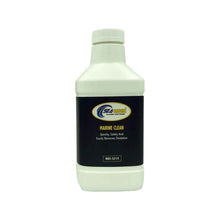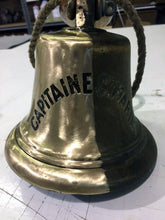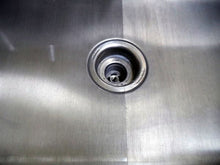-
Can be used safely on hard marine surfaces that show signs of oxidation.
-
Great for general cleaning of Gelcoat, clear coats, and all cured paint types.
-
Removes dirt, oils, and silicone chemicals from the area to be coated for maximum performance.
-
Removes UV fading and oxidation, restoring original color, depth, and shine.
-
Once the oxidation is removed, it will need a sealer applied to protect the surface from UV and other environmental concerns.
-
Concentrated so only a small amount is needed.
-
Not recommended for textured surfaces.
-
Approximate coverage: 3,000 sq. ft. per gallon or 93.75 sq. ft. per 4oz.
Application Guide
NAS-3215 MARINE CLEAN
Quickly, Safely & Easily Removes Oxidation
Marine Clean is designed to remove oxidation safely and easily, without the use of power buffers; merely use with damp terry cloth toweling.
⦁ Great for faded and oxidized automotive paint
⦁ Excellent for faded and oxidized gel-coated boat hulls
⦁ Perfect for faded aircraft finishes that have lost their luster
⦁ Marine Clean is the answer for trucks, buses, and trains that show their age
⦁ For use on outdoor equipment, tractors, metal building facades, etc.
_____________________________________________________________________________
⦁ Apply Marine Clean to a water-dampened, clean terry-cloth towel
⦁ Move across the surface in circular overlapping motions
⦁ If the product starts to dry out, mist a little water over the surface and continue working in a circular motion
⦁ To check the quality of the gloss, rinse off with water using a clean wash mitt or cloth so as to not scratch the finished surface
⦁ If the desired uniform gloss has not been achieved, just re-apply to that area
Once the Gel-Coat or painted finish is visually as desired and uniform in gloss;
⦁ rinse off and dry with a clean-soft towel leaving it ready for a seal coat
⦁ We recommend the application of Speed Coat or Hull Shield to create long term protection
Use MARINE CLEAN to revive the true color within that oxidized paint surface
Material Safety Data Sheet
SECTION 1 – PRODUCT INFORMATION
Supplier:
Nasco World Wide LLC
1281 North Ocean Drive
Singer Island, FL 33404
Emergency Number:
Chem Tel 800-255-3924
IMPORTANT: BEFORE USING ANY MATERIALS,
HAVE ALL PROCESSING PERSONNEL READ THIS DOCUMENT!
SECTION 2 – COMPOSITION/INFORMATION ON INGREDIENTS
CAS No: Chemical name Percentage value
9011-19-2 Poly octa-siloxane 05-25%
5989-27-5 D- Limonene (citrus oil) 15-25%
68603-42-9 Diethanolamide 05-10%
Balance of ingredients are deemed non-hazardous
SECTION 3 – HAZARDS IDENTIFICATION
HMIS RATINGS
Health Hazard: 1 SLIGHT
Flammability Hazard 0
Reactivity Hazard: 0 LEAST
POTENTIAL HEALTH EFFECTS
Routes of Entry:
Eyes, Ingestion, Inhalation, Skin.
Target Organs:
Central Nervous System, Kidneys, Liver.
Irritancy:
Eyes, Respiratory Tract, Skin.
Sensitizing Capability:
None Known.
Reproductive Effects:
None Known.
Cancer Information:
Not known to be carcinogenic.
SHORT-TERM EXPOSURE (ACUTE)
Inhalation:
May cause irritation
Eyes:
May be irritating.
Skin:
May cause irritation or slight dermatitis
Ingestion:
If swallowed, DO NOT induce vomiting. Consult medical attention immediately.
REPEATED EXPOSURE (CHRONIC)
Prolonged or repeated breathing or swallowing of large amounts may cause discomfort.
Synergistic Materials:
None Known.
Medical Conditions Aggravated by Exposure:
None Known.
SECTION 4 – FIRST AID MEASURES
Eye Exposure:
Immediately flush with water for at least 15 minutes. If irritation persists, seek medical attention.
Dermal Exposure:
Wash thoroughly with soap and water. Wash clothing before re-use. If irritation persists, seek medical attention.
Inhalation Exposure:
Remove to fresh air. If breathing is difficult, have trained person administer oxygen. If breathing stops, have trained person administer artificial respiration and seek medical attention immediately.
Oral Exposure:
Do not induce vomiting. Seek medical attention immediately.
SECTION 5 – FIRE FIGHTING MEASURES
Extinguishing Media:
Carbon dioxide, dry chemical powder, or appropriate foam.
Fire Fighting Procedures:
Wear self-contained breathing apparatus and full protective clothing.
Fire and Explosion Hazard:
May emit toxic fumes under fire conditions.
Sensitivity to Mechanical Impact:
Not applicable.
Sensitivity to Static Charge:
NA.
SECTION 6 – ACCIDENTAL RELEASE MEASURES
Personal Precautions:
No precautions.
Environmental Precautions:
Contain liquids and prevent discharge into streams and sewers, control or stop the loss of volatile material to the atmosphere. Do not apply water to the spill. Spills should be reported, if required, to the appropriate local, state, and federal agencies.
Small Spills:
Cover with an inorganic absorbent, such as vermiculite, perlite, ground clay, or sand; sweep up, and dispose of appropriately.
Large Spills:
Dike to contain and pump into drums for disposal. Add inorganic absorbent to remaining material (as above), sweep up, and dispose of appropriately. Clean contaminated area with soap and water.
In case of accidental spill or release, refer to Section 8, Personal Protective Equipment and General Hygiene Practices.
SECTION 7 – HANDLING AND STORAGE
Handling:
Avoid breathing vapors, use adequate ventilation.
Avoid eye contact.
Wear personal protective equipment as described in Section 8, Personal Protective Equipment and General Hygiene Practices.
Wash thoroughly with soap and water after handling.
Avoid sparks, pilot lights, welding operations, and open flame.
Do not reuse containers.
Storage:
Keep container properly closed and properly labeled.
Store in a cool place designated for flammable liquid storage.
Keep away from heat, sparks, and open flame.
Vent periodically to release head pressure.
SECTION 8 – EXPOSURE CONTROLS/PERSONAL PROTECTION
Appropriate Hygienic Practices:
Avoid contact with eyes, skin, and clothing. Avoid breathing vapors, fumes, and mists. Avoid prolonged or repeated exposure. Wash thoroughly after handling, and before eating, drinking, or smoking.
Engineering Controls:
General room ventilation plus local exhaust at points of emission to maintain levels of airborne contaminates below exposure limits.
Respiratory:
If mists or aerosols are generated during handling, wear a respirator equipped with an organic vapor cartridge.
Eye/Face:
Wear safety goggles plus a full-face shield to protect against splashing when appropriate.
Skin:
Wear plastic or rubber apron for splash protection. Wear chemical resistant gloves.
Other:
Emergency shower and eyewash facility should be in close proximity.
SECTION 9 – PHYSICAL AND CHEMICAL PROPERTIES
Appearance and Odor: Liquid, various colors. naphthalenic odor.
VOC (grams / liters): <5%
Freezing Point: 32F
Viscosity: 25-30 seconds (# 2 Zahn Cup)
Flash Point: 194F
Boiling Point: >390F
SECTION 10 – STABILITY AND REACTIVITY
Chemical Stability: Stable
Reacts with: Strong oxidizing agents, strong acids or bases of selected amines..
Hazardous Polymerization: Will not occur.
Hazardous Decomposition Products: Carbon Monoxide, Carbon Dioxide.
SECTION 11 – TOXOLOGICAL INFORMATION
Carcinogenicity Information:
Not listed as carcinogen by NTP (National Toxicology Program); not regulated as a carcinogen by OSHA (Occupational Safety and Health Administration); not evaluated by IARC (International Agency for Research on Cancer).
Reported Human Effects:
No human studies have been conducted with this material. The use of recommended protective equipment should prevent any adverse effects.
SECTION 12 – ECOLOGICAL INFORMATION
This material may be hazardous to aquatic organisms. Avoid release to surface waters and waste treatment systems.
SECTION 13 – DISPOSAL CONSIDERATIONS
Do not mix this product with aqueous or other protic wastes streams. Incinerations of combustible waste material in a permitted facility in accordance with the local, state, and federal regulations is the recommended disposal method.
SECTION 14 – TRANSPORTATION INFORMATION
US DOT:
Proper Shipping Name:
Natural Polymers emulsions
Not regulated
IATA:
Proper Shipping Name: Natural Polymers emulsions
Not regulated
SECTION 15 – REGULATORY INFORMATION
U.S. Federal Regulations:
OSHA Standard 29 CFR 1910.1200 requires that information be provided to employees regarding the hazards of chemicals by means of hazard communication program including labeling, material safety data sheets, training and access to written records. We request that you, and it is your legal duty to, make all information in this Material Safety Data Sheet available to all your employees.
Technical Data Sheet
NAS-3215 Marine Clean
Safely & Easily Removes Oxidation
NAS-3215 MARINE CLEAN formulation safely removes oxidation without the use of harsh abrasives and brings back the luster of dulled finishes
MARINE CLEAN can be easily applied by hand in direct sun and rinses off easily with soapy water
NAS-3215 MARINE CLEAN is approved and safe for use in and around USA waterways (if used as directed)
MARINE CLEAN leaves the surface bare of protection. The surface should be protected with a sealer coat
Renews Old Dull Finishes • Brings Back the Luster • Even in Direct Sunlight
NAS-3215 Marine Clean Properties:
⦁ Color Off-white
⦁ Viscosity 32 sec. #2 Zahn
⦁ Percent of Solids Concentrated
⦁ Odor (liquid) Fresh Scent
⦁ V.O.C. None
⦁ Halogens None
⦁ RoHS Compliant
⦁ REACH Compliant






